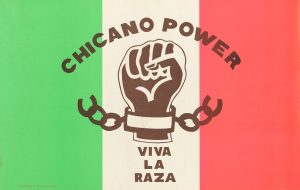“El Movimiento,” also known as the “Chicano Movement,” emerged out of political and economic discourse against Mexican Americans in the 1960s. The Chicano Movement was primarily inspired by the civil rights movement, the antiwar movement, and most importantly, the farmworkers movement.

Chicano movement poster with “Chicano Power” and “Viva La Raza” over a Mexican flag, ca. 1970s. [Collection of the Smithsonian National Museum of African American History and Culture © Platt Poster Company] latinoamerican2.abc-clio.com/Search/Display/2267122

Dolores Huerta (left) and César Chávez (right). Co-founders of the UFW. www.history.com/news/chicano-movement
The Chicano movement sparked many different genres drawn from Mexican folk and popular music. But most commonly from this movement, huelga songs were used and created to inspire others to rise up against these abusive farm bosses and were typically played on the picket lines and at meetings. These huelga songs were written in forms such as marches, corridos, and rancheras. On top of these forms, some huelga songs were adaptations of other tunes. For example, the civil rights song and text from “We Shall Overcome” was translated to become “Nosotros Venceremos.”
Of all these songs that were inspired by this movement, the one song that was most well-known was a folk song called “De Colores,” which actually came from Spain, and the Cursillo movement in the Spanish Catholic Church in the 1940s. This song is still well known today.
Works Cited:
- Azcona, Estevan C. “Chicano Movement Music.” The American Mosaic: The Latino American Experience, ABC-CLIO, 2024, latinoamerican2.abc-clio.com/Search/Display/1329550. Accessed 2 Oct. 2024.
- “Chicano Movement Poster.” The American Mosaic: The Latino American Experience, ABC-CLIO, 2024, latinoamerican2.abc-clio.com/Search/Display/2267122. Accessed 2 Oct. 2024.
- Carrillo, Karen Juanita. “How the Chicano Movement Championed Mexican‑American Identity and Fought for Change.” History.Com, A&E Television Networks, 25 July 2023, www.history.com/news/chicano-movement.
- “Interview with Chicano Studies Scholar [:53].” The American Mosaic: The Latino American Experience, ABC-CLIO, 2024, latinoamerican2.abc-clio.com/Search/Display/2256112. Accessed 2 Oct. 2024.
- Seeger, Pete. “We Shall Overcome.” Antiwar Songs (AWS) – We Shall Overcome, antiwarsongs.org/confronta.php?versions=1&ver=18323&id=1075&ver2=-1&lang=en. Accessed 2 Oct. 2024.
- “De Colores.” Youtube, 17 Dec. 2012, https://youtu.be/9rn43pLNtlY?si=zH8-_msl9jjk4D3r. Accessed 2 Oct. 2024.

